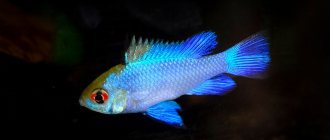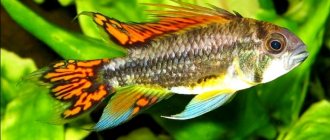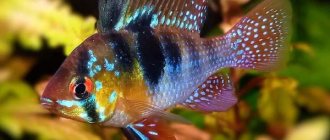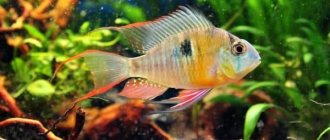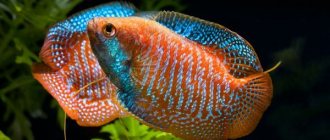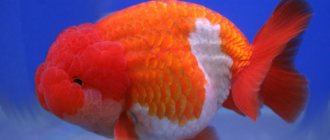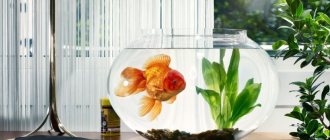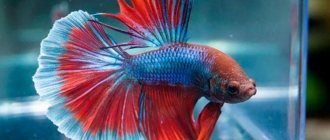Apistogramma Ramirezi (Microgeophagus ramirezi, Apistogramma, Papiliochromis ramirezi)
Promotion Moscow and Moscow Region: Cashback 10% + 20% discount on the 1st order of services!
Apistogramma ramirezi
Aquarium fish of the cichlid or cichlid family (Cichlidae). The fish also goes by names: Chromis butterfly, Apistogramma butterfly, Venezuelan butterfly. Latin names: Microgeophagus ramirezi (Myers, Harry, 1948). as well as Apistogramma ramirezi, Papiliochromis ramirezi.
Fish size
S - up to 3 cm, M - up to 4 cm, L - up to 5 cm, XL - up to 5 cm.
Habitat The natural habitat of the Ramirezi Apistogramma is the Orinoco River basin (western part), the fish are also acclimatized in Indonesia and Southeast Asia.
Appearance and sexual differences The Venezuelan butterfly is one of the most striking and elegant representatives of the dwarf American cichlid species. Its small size and peaceful behavior have made this fish widely popular among aquarists, both experienced and beginners. Ramirezi's apistogram reaches 5-7 cm in size. The general background color of the body is yellow-brown with a reddish-orange tint in the front part. In males, the low tide, especially during the spawning period, becomes bright red. Greenish and blue sparkles are scattered in large quantities on the head, back of the body and fins. The female's abdomen is colored crimson. There is no notch on the tail; the anal fin has a rounded shape. The female's pelvic and dorsal fins are somewhat shorter than those of the males, as, in general, are the case with most representatives of this family. The first rays of the fin of a sexually mature male are elongated.
Conditions of keeping Apistogramma Ramirezi is a very peaceful aquarium fish, it gets along well with other peaceful neighbors, it does not damage aquarium plants or dig up the soil. The fish are kept in a densely planted tropical aquarium, the volume of which is at least 20 liters for a pair of fish. Water parameters for keeping: acidity pH 6.5-7.5, hardness dH not higher than 12°, temperature from 24 to 32°C. One of the features of keeping this type of cichlid is the need for elevated temperatures. Thanks to this feature, the butterfly apistogram is adjacent to heat-loving discus. Life expectancy at elevated temperatures is on average about two years, at moderate temperatures – 4 years. But in the latter case, the fish is exposed to disease. Fish are sensitive to water quality. They feel most comfortable in running water, but if it is not possible to create a flow, it is necessary to change 30% of the water in the aquarium once a week or daily up to 10% of the water in the aquarium. The replacement water must be settled, since the fish are very sensitive to the chlorine content in the water. Aeration and filtration of water are required. During the spawning period, Ramiresi's peaceful apistogram becomes territorial.
Nutrition
Apistogramma Ramirezi eats all types of food, but because... Since this species is carnivorous, it is necessary to take into account the high protein content in dry food. When using dry food, overfeeding should be avoided. It is advisable to feed the fish with live or frozen food.
Breeding Ramirezi Apistograms tend to form stable pairs. Sexual maturity in fish occurs at the age of 4-6 months when they reach a length of approximately 3 cm. It is better to use a spawning tank with a volume of more than 15 liters as a spawning site. In the spawning tank, the water temperature should be 1-3°C higher than in the general aquarium. Fresh soft water, added in small quantities over several days, acts as a spawning stimulator. Apistogramma Ramirezi spawns on open surfaces, the inner walls of flower pots or an aquarium. Sometimes inexperienced parents eat the eggs, and in a community aquarium they can be destroyed by neighbors. Productivity is 100-400 eggs. Both parents care for the offspring, but the male is dominant in this matter. After the incubation period (2-4 days) the fry hatch. After this, the temperature is gradually reduced. In the first few days of life, the male transfers the offspring to holes in the ground that he dug in advance, and after 3-5 days they begin to swim on their own. At this time, the female is removed. Starter food: cyclops and brine shrimp nauplii, ciliates.
Cichlids: Apistogramma Ramirezi Electric blue - 3-4 cm
Description Apistogramma ramirezi var. Electric Blue Ram.
Peaceful, very impressive aquarium fish. Length - up to 6 cm. The general background is neon blue, in the front part of the body with a reddish-orange tint. They are most spectacular during spawning. In sexually mature males, the first fin rays are elongated. The tail is without a notch, the anal fin is rounded. Unlike other varieties of electric blue ramirez, females are almost as beautiful as males. Looks especially beautiful on a dark blue (blue) and black background of the aquarium. Life expectancy is 3 years.
Origin:
A selection form of one of the most popular dwarf cichlids in the aquarium hobby. It differs from the nominative species in body coloration. These fish were bred by selectors from Microgeophagus ramirezi, presumably in 2009.
Sex differences:
Males are larger than females. Males have longer dorsal and anal fins than females.
Compatibility: Non-aggressive species, compatible with any peaceful warm-water fish. They don't pay attention to anyone. There is experience of keeping them together with other dwarf cichlids, laliuses, neons, glass catfish, even with microrasboras and shrimp. Territoriality manifested itself only during the spawning period. But they mainly chase only representatives of their own kind, although not much (the Lalius fight harder).
Content:
The fish is very calm, does not dig the soil, does not damage plants. The minimum volume of the aquarium is 30-40 liters per couple. Water hardness up to 12°dGH, pH 5.5-7.5, Water temperature - 25-32°C. They tolerate short-term increases in temperature up to 35-36 °C.
Effective filtration and regular water changes (up to 20% weekly) are preferred. In this case, fresh water must be added very little.
At what time they acquire their final color (just so bright and saturated) is unknown, since even in one brood there are individuals that are well colored and others that are not so well colored.
The depth of coloring depends greatly on the food, background and lighting of the aquarium itself. If all is well, then within a month they are already painted. When fed with one brine shrimp, they begin to look red. Fish grow very slowly. At the age of 5-6 months they are still 3.5-4 cm.
Feeding:
Fish should not be overfed. It is not advisable to feed bloodworms or whole tubifex. The fish eat greedily and grab pieces without looking (they grab them so that the bloodworm or tubifex sticks out of the gills). Soon they rise to the surface, and a little later they die. Experienced breeders feed very carefully, mainly with live or frozen cyclops, brine shrimp, cut and washed tubifex - 1-2 times a day in small portions. You can gradually switch to flake food for small cichlids. Although I have experience feeding all available food, I do it very carefully and little by little.
Breeding:
They begin to spawn very early. Young individuals, having reached a size of 3 cm, already dig a hole in the corner and lay small eggs there. After spawning, young individuals, as a rule, lose interest in their clutch after 2-3 days and the eggs disappear. The larvae hatch very small and tender. For the first four days, it is advisable to feed juveniles with ciliates every three hours, regardless of night or day. These are the most critical days. On the fifth day they already begin to take brine shrimp and live dust.
Apistogramma electric blue
Blue microgeophagus Ramerezi
Description
It was obtained through selection and is one of the colorful forms of dwarf cichlids.
These fish are undemanding in terms of keeping conditions and can be recommended for beginning aquarists. These fish have a shorter and more elongated body. The body is a sparkling neon blue. The head of the male, in overhead lighting, is golden in color.
With age, the brownish-orange forehead of males becomes steep, while in females it remains flat. Males are noticeably larger (longer) than females. It is difficult to distinguish them by gender even at the age of three months - both males and females are colored absolutely the same. Adult six-month-old fish can easily be distinguished by sex precisely by the noticeable difference in size.
Content
A relatively small aquarium with a volume of 30 liters or more per pair is suitable for keeping fish.
It is advisable to keep fish in a ratio of 1 male to 3 females. Sometimes clashes arise between females, which, however, end without injury. Fish swim in all layers of water. In general, these fish lead a peaceful lifestyle and can be kept in a common aquarium with fish of similar behavior. The only thing you shouldn’t keep them with is the small species of shrimp that apistogrammas prey on. The water parameters for keeping fish are as follows: temperature 25-32°C, hardness dH 1-14°, acidity pH 5.4-7.5. It is necessary to monitor the lower threshold of water temperature, because... at temperatures below 25°C, the lifespan of fish is significantly reduced. Filtration, aeration and weekly replacement of ¼ of the aquarium water with fresh water are necessary. It is advisable to add pieces of peat to the filter element of the water filter. It is also advisable to put several alder cones in the aquarium.
Reproduction
Apistogramma electric blue reaches its sexual maturity at the age of 6-8 months.
For successful fish breeding, care must be taken that the water in the spawning tank is soft and acidic, otherwise the larvae will not hatch from the eggs. Typically, spawning occurs at intervals of 10-15 days. It has been noticed that as fish grow older, the frequency of spawning decreases.
The female lays eggs on a flat stone, in a depression in the ground, or on the outer side of a plant leaf of suitable size. After a few days, tiny larvae hatch from the eggs and are fed live dust at least 4 times a day. After a week, the fry’s menu is expanded and they are given artemia.
The growth rate of the fry is low - at 5 months of age their size is about 3 cm.
The lifespan of Apistogramma electric blue in aquarium conditions is about 3-4 years.
How the fry are colored: by the end of the first month, after swimming, they have an even steel-gray color. In the second month of life, the gill covers begin to turn blue. Then the paired ventral fins turn blue. Following the abdominal ones, the remaining fins turn blue. And then the scales begin to gain color. With age, the coloring becomes more intense; they are fully colored only at the age of 4 months. Each subsequent brood from already bred fish “fades” a little. The blue color remains, but it is paler and has a different shade, closer to blue, while the original Singaporean manufacturers are always a rich cornflower blue color.
Apistogramma of a cockatoo
Apistogramma of a cockatoo
Habitat in nature
Peruvian part of the Amazon, Ucayali, Putumayo, Rio Jur, Peru, Colombia, Brazil
Description
The male is up to 7-9 cm, the female is 5-7 cm. The physique of the fish is quite powerful. A distinctive feature is the slightly protruding lower jaw and the characteristic dorsal fin.
The main body color is from gray-yellow to olive-brownish with a blue sheen on the side, the back is olive-green, the chest and belly are yellowish to orange. A dark stripe running from the snout along the body and ending with a dark spot in a light edging near the tail. The color of the fins varies from bluish to greenish.
Sexual dimorphism is pronounced in adult fish. The male is much larger and brighter than the female, his ventral, dorsal and caudal fins are greatly elongated. Males have highly elongated first rays of the high dorsal fin, reminiscent of the crest of a cockatoo. The caudal and dorsal fins may be orange to red with yellow spots. The upper lobes of the caudal fin have red ocellated spots. The pelvic and anal fins are yellow or orange.
The female is colored simpler than the male, gray-yellow with a bluish sheen. During the period of caring for the offspring, it becomes a rich lemon yellow color with a black horizontal stripe. There is a form without spots on the tail. The pelvic fins are black with a golden border. In addition to numerous natural color forms, a large number of artificially bred breeds have recently appeared.
Content
A peaceful little cichlid that sticks to the bottom layer. Can be kept with fish that swim near the surface; they do not get along well with bottom fish. It lives and reproduces without problems in both soft and hard water, and does not need acidic water, like other Apistograms. Volume from 50 liters per couple, due to the territoriality of males. Fish should be kept in a small group consisting of one male and several females.
In small aquariums it is better to have one female, because if the bottom area is too small, then they will not be able to share the territory and will be beaten. Several males can only be kept in large aquariums. With seemingly calm behavior, the fish suddenly flare up in aggression towards each other and other fish in the aquarium.
In order to minimize this behavior of fish, the aquarium must have sufficient living space and contain a large number of hiding places in the form of flat stones stacked on top of each other, caves, driftwood, coconut shells, and the aquarium must be densely planted. There must be caves with a fairly small entrance.
Males occupy a large territory, within which there are several females, each with their own small territory. Usually the male occupies a shelter, where he stays most of the time, emerging only at the time of feeding. Spends most of its time at the bottom, leisurely swimming from one shelter to another.
The soil in the aquarium should be soft, preferably sandy, because cockatoos dig holes in their shelters, into which they subsequently spawn. The species is very peaceful in relation to other fish (although large specimens can even snack on neon), and usually in a common aquarium it is “beaten” by more agile neighbors, who often push several phlegmatic cockatoos away from the feeder. Fish are very sensitive to high levels of nitrates. Filtration, aeration, and regular weekly water changes are required. Willingly feeds on both live and artificial food.
Reproduction
They mature at 9-11 months. Reproduction of this fish does not cause any trouble to the owner and takes place without any preparation. By providing the fish with conditions in the aquarium that are similar to their permanent habitats in nature, you can easily achieve their spawning. When breeding, you should use the brightest males and females. The female hides the eggs in her shelter, and at this time she acquires a characteristic yellow color.
Subsequently, the female carefully cares for her eggs, fanning them with her fins. The male protects the mother and offspring by patrolling the territory. The female is aggressive during the spawning period. Ideal for beginner dwarf cichlid hobbyists. They live up to 4 years. dH 3-12°; pH 6.0-7.5; T 23-27°C.
